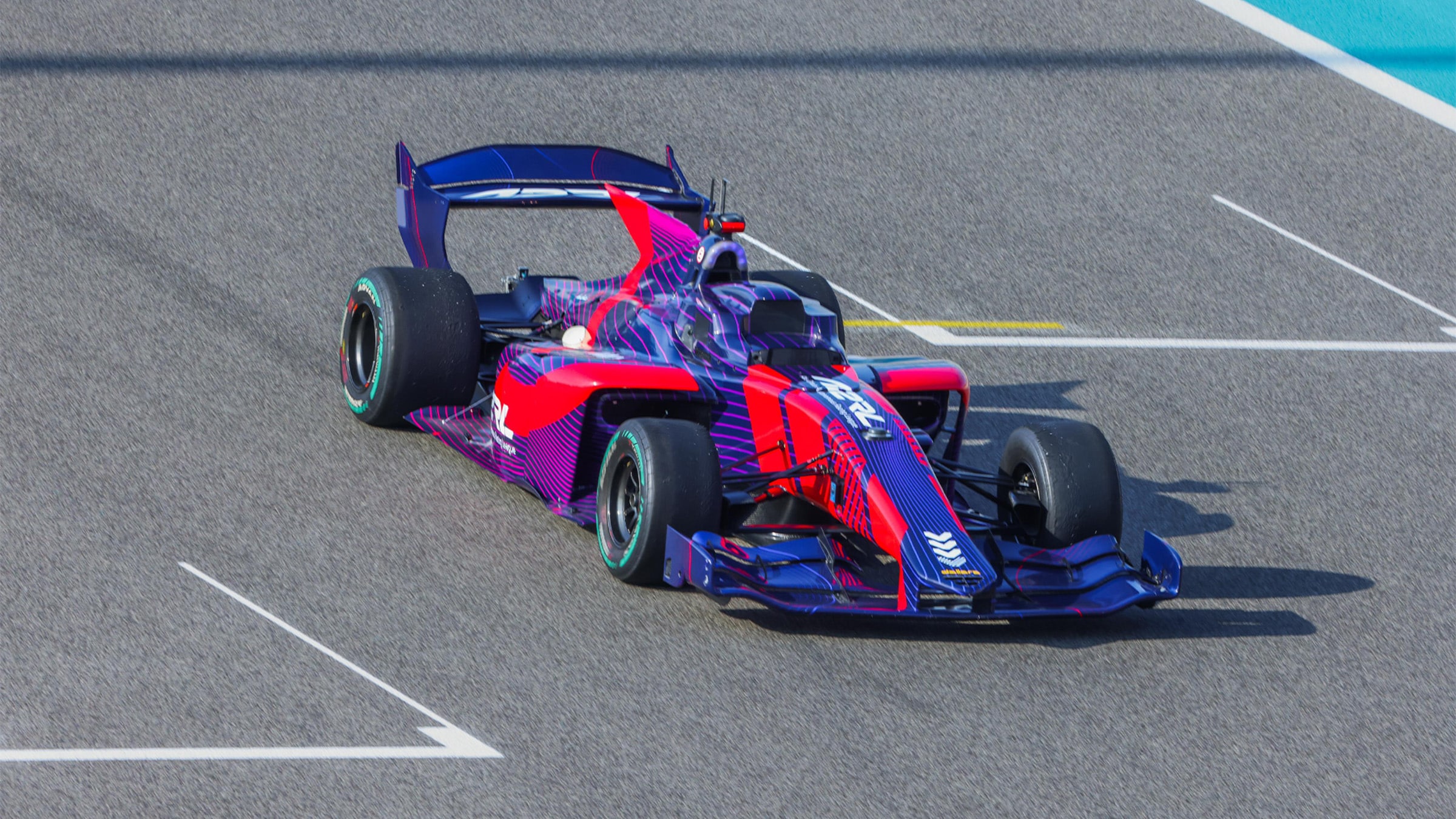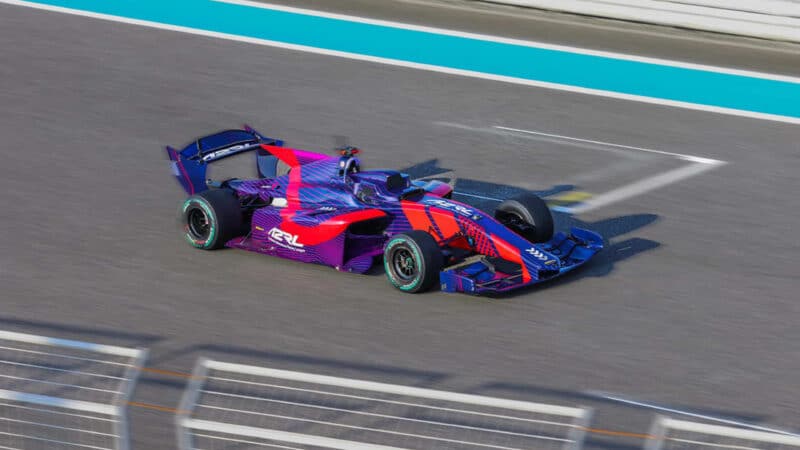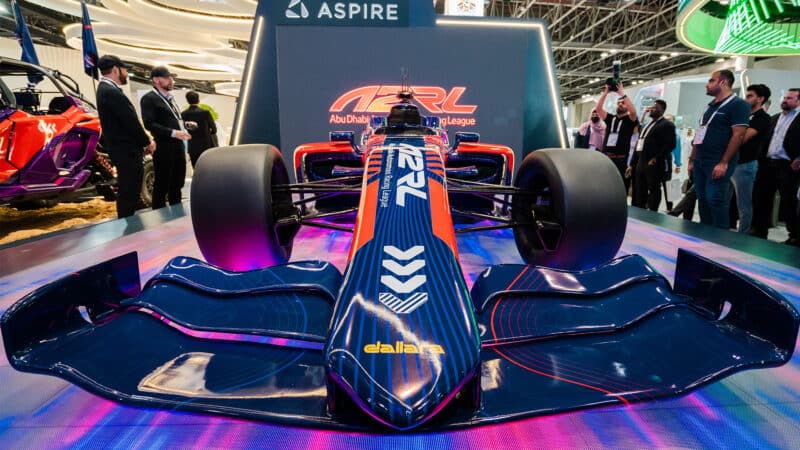In the cockpit sits an on-board computer — otherwise known as the ‘autonomous stack’ — which houses the brain of the car. Each team received identical stacks with a base-level of software, already capable of driving the car autonomously. This was initially developed by human drivers, whose telemetry helped the AI identify competitive racing lines, braking zones, the level of grip available at each corner and the effect of tyre wear.
From there, it has been up to the teams to optimise this software further, smartening their AI with improved pace and racecraft.
This is typically done with a machine learning process where, through practice and simulator runs that are fed through the AI, it builds up a higher level of stored knowledge, making it more likely to respond appropriately in the heat of a race. Fed with data from the on-board cameras and sensors, each team’s autonomous stack must decide on the course of action that is most likely to win the race, controlling the accelerator, brakes, steering and gears with a drive-by-wire system
Each team is expected to take a slightly different approach when it comes to the characteristics of their robot drivers. Some may choose a ‘tortoise’ approach: lapping Yas Marina slowly and steadily to maximise their chances of reaching the finish line. Others may train their software to be the ‘hare’ — pushing the limits of the car to set the fastest lap times, but with the added risk of crashing out.
The biggest hazard is likely to be when it comes to interacting with other cars. For example, the AI software will have to decide whether it is safe to move across on a rival and close the door, or if it’s too late, and surrendering the position is the only sensible approach.
Ultimately, it’s hoped that the techniques honed in the heat of competition will benefit AI development in general.
The format

Which driverless car will come out on top in Abu Dhabi?
A2RL
While the full details on the A2RL’s inaugural race weekend are yet to be released, it is expected to follow a traditional grand prix schedule with final practice on Thursday, qualifying on Friday and the race on Saturday. Although the name refers to a league, the Abu Dhabi event is currently a one-off.
Practice
In the two weeks leading up to the event, all eight A2RL teams have been given extensive access to the Yas Marina circuit to fully test their cars and their autonomous software.
This is an important part of the machine learning phase in the development of AI technology, as teams will capture real-world data for their car to analyse. In the lead up to the live practice sessions, teams have been limited to using simulation data.
The final practice session before the event will take place on Thursday April 25, in which teams will make their final preparations before competitive action begins.
Pre-qualifiers
All eight teams will compete in pre-qualifying in the morning on Friday April 26, but little is known about the format.
Tom McCarthy, executive director of Abu Dhabi state investor Aspire which set up the series, previously told Motor Sport that each team would participate in various events across the weekend including time trials and sprint races as well as a final longer race.
In its own preview of the weekend, the A2RL also stated that following the qualifier, the best teams in the A2RL will then compete in Saturday’s final race based on their “speed and performance”.
AI vs Human and A2RL Grand Final
The first racing action of the weekend will aim to answer a burning question: can the current level of AI beat a professional driver?
Team TII — a leading global advanced technology research centre in Abu Dhabi which partners A2RL — will pit an autonomous car of its own up against former Red Bull and Toro Rosso F1 driver Daniil Kvyat in a 45-minute showdown around the Yas Marina Circuit.
Following that, the teams which have qualified for the A2RL Grand Final will finally be let loose to race wheel-to-wheel for the first time in a similar 45-minute long format.
The teams
Eight teams from seven different countries will compete in the inaugural A2RL event — some professional outfits while others are funded by world-renowned universities. A team principal will represent each team similarly to how they do in F1, with an AI-generated representative acting as ‘the driver’.
Humda
Team principal: Armin Bogar-Nemeth
Supported by Széchenyi István University Group in Hungary, Humda Labs was invited to participate in the A2RL after a two-year research and development project that focused around “sustainable national automotive and motor sport R&D programmes, the implementation of AI-based racing algorithm simulations and alternative powertrain experimental developments.”
The team has also previously competed in AI-driven motor sport with F1Tenth robotics, in which teams programmed AI modules to race 1:10 scale cars. At the first event held in London, both of Humda Labs’ cars finished inside the top 16 out of 40 entrants and at another race in Detroit, its cars finished fourth and fifth. These results earned the team a place in A2RL.
Unimore
Team principal: Alessandro Toschi
The official autonomous racing team of the University of Modena and Reggio Emilia in Italy, Unimore is one of the more experienced outfits in the A2RL.
Having previously worked with the Technology Innovation Institute in Abu Dhabi in the IndyCar Autonomous Challenge — another AI competition that features a series of overtaking challenges rather than open racing — the team already has real-world experience in operating a full sized car.
Unimore finished second in the series debut at Indianapolis in 2021, and has since claimed third at both the Texas Motor Speedway in 2022 and at Monza during an exhibition event in 2023.
Tum
Team principal: Armin Bogar-Nemeth
Racing out of the Technical University of Munich in Germany, Team TUM arrives in Abu Dhabi in fighting form, having already secured its first autonomous victory of the year: lapping the Las Vegas Motor Speedway faster than anyone else during the opening round of the 2024 IndyCar Autonomous Challenge.
The team’s last win had previously come at the very first IAC event in 2021 at Indianapolis, and it remained a competitive force in meantime with three second-place finishes in Las Vegas (2022 and 2023) and Monza (2023).
TUM was also one of only two teams to compete the Roborace autonomous series, where two AI prototype sports cars duelled in a restricted form of racing. TUM finished second but has been digesting more knowledge and pace ever since.
Fly Eagle
Team principal: Nadya Abdel Madjid
Team Fly Eagle will be one of two teams which consisting of software engineers from more than one country. Operating out of Khalifa University in Abu Dhabi, students from both China and the UAE will combine their knowledge in an effort to reach the front of the grid.
The team was first established in 2017 and has a history of success in the Mohammed Bin Zayed International Robotics Challenge, in which it has won a series of challenges which involve designing and developing UAVs and drones.
PoliMove
Team principal: Rodrigo Senofieni
Renowned as the most successful team in the IndyCar Autonomous Challenge, the Italian Team PoliMove from Politecnico di Milano will be among the favourites to reach the chequered flag first in Abu Dhabi. After finishing third during its first IndyCar Autonomous Challenge event back in 2021, the team then reeled off four successive IAC victories in Las Vegas (2022 and 2023), Texas and Monza.
That final victory could eventually end up being the most crucial one, as a history of success around full-scale grand prix circuits could benefit the team’s chances in Abu Dhabi.
The team itself is made up of a group of researchers whose main goal is to “always finish the race first.”
Constructor
Team principal: Armin Bogar-Nemeth
Entering the A2RL “under the banner of innovation” the Constructor University from Germany comes to Abu Dhabi with an impressive autonomous racing team now acting as its partner.
Constructor Racing won the 2021 Roborace Series by a commanding 1500-point margin over the likes of PoliMOVE and Arrival Racing — who won the first ever autonomous race back in 2019 — and will join forces with Constructor University for the first time having previously been based in Switzerland.
The team boasts a “state-of-the-art AI model” which team principal Ilya Shimchik has stated should suit A2RL “perfectly.”
“We are here not only to compete,” he said. “We are racing to innovate and enhance the safety and proficiency of autonomous driving technology.”
Code 19
Team principal: Lawrence Walter
As the world’s first professional autonomous racing team, USA’s Code 19 could have a slight advantage over most in the A2RL and has already been noted as a “strong competitor” by the league itself.
Founded by military veterans based in Indianapolis with a passion for innovation and motor sport, the team has developed the formidable-sounding “Maverick AI” to pilot its car.
“We’re here to win,” said Lawrence Walter, Team Principal of Code 19 Racing. “A2RL is an R&D playground for AI, offering unique and attractive opportunities for corporate partners. Our team is ready to compete against the top global minds in autonomy while carrying the torch of American innovation.”
Kinetiz
Team principal: Tareq Albannay
Made up of team members from the UAE and Singapore, the Kinetiz Racing Team aims to use the A2RL as a test bed for challenging its AI systems.
The team itself is a division of Kintsugi, a leading technology company which innovates not only in the AI sector but also in aerospace, robotics and power.
“Each lap by Team Kinetiz is a stride into the new frontier,” the team states on its official website. “As we navigate the race’s complexities, our focus remains steadfast on pioneering developments that will shape the future of autonomous technology, making this endeavour a cornerstone in our journey towards a tech-driven tomorrow.”



